Inheritance
1/39
There's no tags or description
Looks like no tags are added yet.
Name | Mastery | Learn | Test | Matching | Spaced |
|---|
No study sessions yet.
40 Terms
What are homologous chromosomes
diploid organism has two sets of chromosomes, one from each parent
chromosomes of a homologous pair:
pair with each other during prophase I of meiosis
have exactly the same order of gene loci
have centromeres in the same position and arms of the same length
chromosomes which determine the same characteristics (e.g. eye colour, blood group) are called homologous chromosomes (or homologs), they do mot need to be genetically identical
What is a gene
gene is a discrete unit of hereditary information.
it is a specific sequence of nucleotides (Fig. 1.3) in the DNA molecule which codes for a RNA (e.g. tRNA, rRNA, telomerase RNA) or polypeptide (e.g. amylase)
What is a gene locus
position occupied by a gene on a chromosome
What is a allele
alternative form of the same gene responsible for variation in a particular characteristic
alleles of a gene occupy the same gene locus on homologous chromosomes
alleles cause variation due to a slight difference in the nucleic acid sequence, which give rise to different forms of the protein.
What is pure breeding
members of a pure line are homozygous at the gene loci and are said to breed true
What is phenotype
phenotype is the observable characteristics of an individual, this is dependent on the genotype
What is genotype
genotype is the genetic makeup of an organism determined by the alleles present in the genome.
What is dominant allele
an allele that is fully expressed in the phenotype even in the presence of a differentallele, i.e. expressed in both homozygous and heterozygous condition.
What is recessive allele
allele which is expressed in the phenotype only in the presence of another identical,allele, i.e. expressed only in homozygous condition
What are mulitple alleles
gene that has more than two different types of alleles in a given population
regardless of the number of different alleles, only two can be present in a diploid organism
What is codominace
phenomenon in which two alleles which are expressed equally in the phenotype of a heterozygote
What is the explanation for co dominance
four blood groups (A, B, AB and O) is a result of different combinations of 3 alleles IA, IB and IO
IA codes for an enzyme the converts antigen H to antigen A on red blood cells
IB codes for another enzyme that converts antigen H to antigen B on red blood cells
IO codes for a non-functional enzyme. Antigen H remains as it is (blood group O).
alleles IA and IB are codominant. A heterozygote (IAIB) produces both enzymes, resulting in both antigen A and B on red blood cells
both alleles IA and IB are dominant to the IO allele
What is incomplete dominace
phenomenon in which one allele for a specific trait is not completely dominant over the other allele, resulting in heterozygote offspring having a phenotype which is intermediate of that of the homozygous parents
What is an example of incomplete dominance
R represents the allele that codes for an enzyme that synthesizes red pigment
r represents the allele that codes for a non-functional enzyme that cannot synthesize any pigment
in RR genotype, there is sufficient enzymes present → large amount of red pigments synthesized → red colour
in Rr genotype, there is insufficient enzymes present → small amount of red pigments synthesized → pink colour
in rr genotype, there are no enzymes → no pigments synthesized → white colour.
State Medel’s first law
each pair of alleles of a gene segregates and each gamete receives one of each pair of alleles
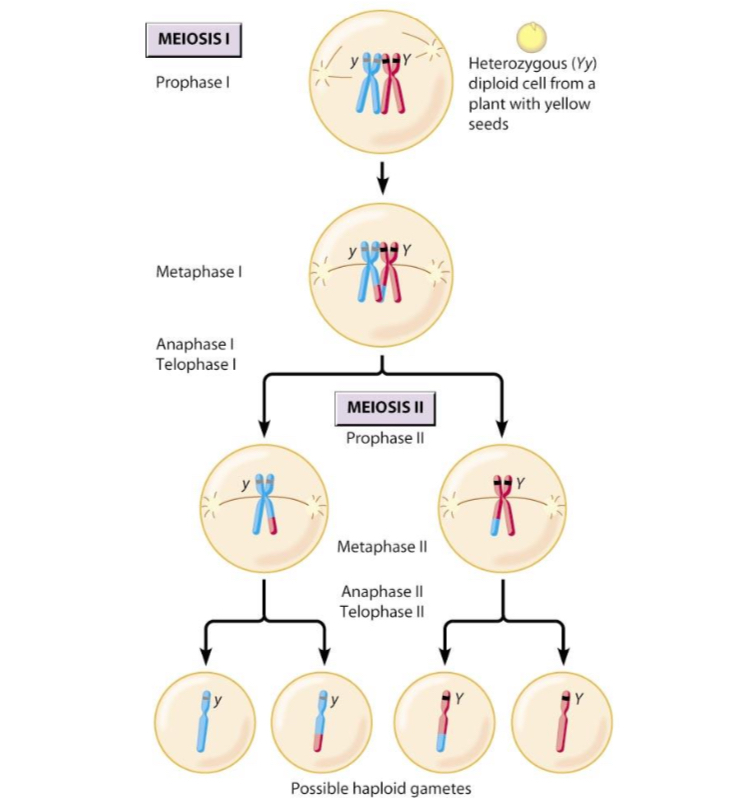
Why did medel choose pea plamt
there were several varieties available, which had quite distinct characteristics, many traits occur in two alternate forms that are easy to distinguish
plants were easy to cultivate and produce many offspring.
short generation time - develop quickly hence results can be seen within a short time.
reproductive structures were completely enclosed by the petals, which ensure self-pollination, leading to pure breeding, whereby the same characteristics are produced generation after generation
artificial cross-breeding between varieties was possible, resulting in hybrids that were completely fertile.
What is mono hybrid
inheritance of one characteristic controlled by alleles of one gene
What is dihybrid
dihybrid inheritance involves the inheritance of two characteristics which are controlled by alleles of two different genes, respectively
What is Mendel’s second law,
law of independent assortment or Mendel’s Second Law states that the alleles of one gene segregate independently of the alleles of another gene during gamete formation
State Morgans experiment explanation
genes for these 2 characteristics are on the same chromosome (i.e. they are linked).
they are therefore usually inherited together
the appearance of the non-parental (recombinant) phenotypes is due to crossing over during prophase I of meiosis.
there will be no fixed ratio for offspring of different phenotypes.
What is a linkage group
All genes on the same chromosome form a linkage group and are usually passed into the same gamete. These genes are inherited together, and as a result, genes on the same chromosome usually do not show independent assortment.
How is genetic recombination formed
crossing over results in genetic recombination
gamete that contains the recombinant chromatid is known as recombinant gamete
offspring that exhibits new combinations of
characteristics that are different from their parents are known as recombinant
sequence of events accounts for the occurrence of recombinant phenotypes in Morgan’s test cross
How is sex determined
microscopic examinations of the chromosome structure of a range of mammals revealed that males and females showed certain chromosomal differences
homologous chromosomes are found in all cells except for one pair of chromosomes which always shows differences between the sexes
these are known as the sex chromosomes (heterosomes) sex chromosomes (named X and Y) are involved in sex determination. All other chromosomes are known as autosomal chromosomes or autosomes
in humans, for example, the first 22 pairs of chromosomes are autosomes. In human females, the 23rd pair is a pair of sex chromosomes which are homologous. In human males, however, the sex chromosomes are not homologous
What is the female genotype in humans concerning sex chromosomes?
two X chromosomes (genotype XX).
during gamete formation, the female only produces one type of gamete (with respect to sex chromosomes) – all the egg cells contain an X chromosome.
humans, the female is the homogametic sex.
Describe sex link
genes carried on the sex chromosomes are said to be sex-linked
Y chromosome is smaller than the X chromosome, and carries very few genes compared to the X chromosome, which carries over 1,000 genes. There is a portion of the X chromosome with no homologous region on the Y chromosome
characteristics that are determined by genes carried on the non-homologous region of the X
chromosome will appear in males even if they are recessive
males have a higher tendency to inherit sex-linked diseases as they only have one X chromosome, whereas females have two X chromosomes
What is the male genotype in humans concerning sex chromosomes?
one X chromosome and one Y chromosome. (Genotype XY).
during gamete formation, the male produces two types of gametes (with respect to the sex chromosomes) - 50% of the sperms carry the X chromosome and the other 50% carry the Y chromosome
humans, the male is the heterogametic sex
Why is it more common for males to express X linked traits
males carry only one X chromosomes
thus they cannot be heterozygous or carrier for colour vision gene
only one copy of X chromosome liked allele is sufficient to cause them to be colour blind
State autosomal dominant inheritance pattern
trait is determined by a dominant allele
every affected individual has at least an affected parent
it appears in every generation
trait is autosomal (i.e. not sex-linked)
equal numbers of males and females are affected
male lpasses the trait to his son. In sex-linked, father contributes the Y-chromosome to his son hence does not pass on the X-linked disease to his son
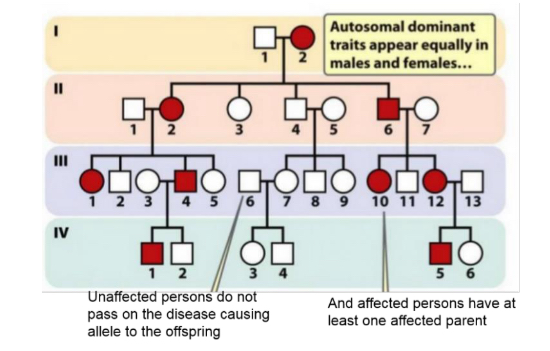
State autosomal recessive inheritance pattern
trait is determined by a recessive allele
an affected individual may have unaffected parents
the recessive trait skipped a generation
trait is autosomal (i.e. not sex-linked) because
unaffected heterozygote parents each passed a copy of the recessive allele to the affected daughter
if the recessive allele is sex-linked, the daughter would not be affected as she would inherit the dominant allele on the X chromosome (normal) from the unaffected father
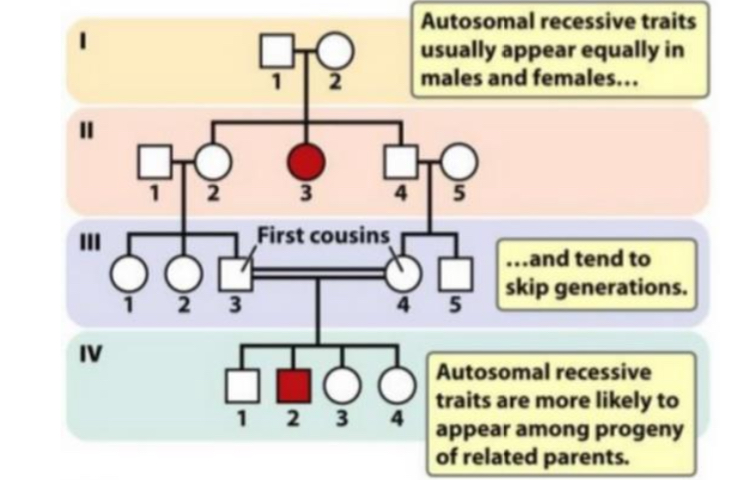
State sex linked recessive inheritance pattern
This trait is determined by a sex-linked recessive allele because
o none of the sons of an affected male (and an unaffected female) is affected
o sons of an affected female are affected (not shown in Fig. 5.5)
o more males than females are affected
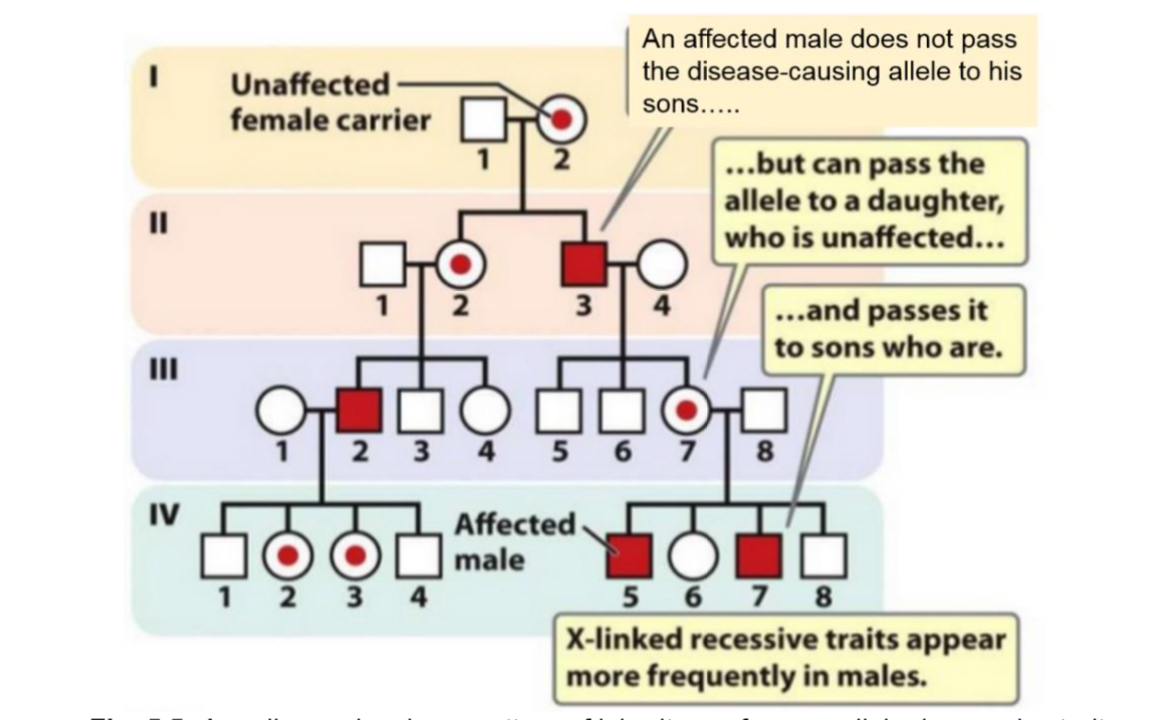
State sex linked dominant inheritance pattern
trait is determined by a sex-linked dominant allele
all daughters of an affected male individual are affected
affected male does not pass the disease to his sons, since sons receive Y chromosome from their father.
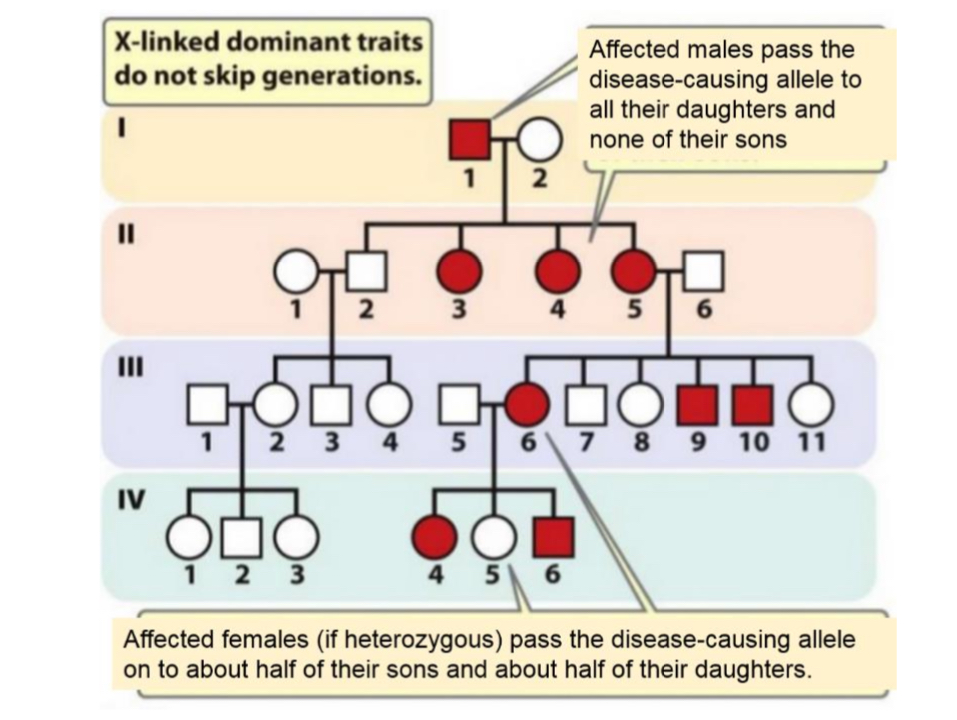
How does crossing over in meiosis I increase variation
homologous chromosomes pair up
chiasmata form between non-sister chromatids of homologous chromosomes.
corresponding non-sister chromatids may break and rejoin at any point along their length where chiasmata formed
as a result, corresponding alleles are exchanged
chiasmata can occur almost anywhere on the chromatids, and the number of chiasmata may vary from zero to as many as eight
amount of genetic variation resulting from this reshuffling of alleles between homologous chromosomes can be infinite.
produces new linkage groups and so provides a major source of genetic recombination of alleles
exact genotypes produced depend on the number of chiasmata and the positions of the genes relative to the sites of crossing over
crossing over is not the same as mutation as crossing over does not create new genes / alleles. It merely reshuffles the alleles.
How does random fertilisation help variation
random nature of fertilization adds to the genetic variations arising from crossing over and independent assortment and segregation of chromosomes in meiosis
zygote is formed when an ovum (1 of approximately 8 million) is fertilized by a single sperm cell (1 of approximately 8 million possible combinations).
without considering crossing over, random fusion of sperm and egg will produce a zygote with any of the over 70 trillion diploid combinations (223 x 223).
if crossing over is considered, the number of possibilities is infinite
How does Independent assortment and segregation of chromatids during metaphase II and anaphase II of meiosis respectively help variation
during metaphase II, the orientation of pairs of chromatids is also random and determines which
chromatids migrate to opposite poles of the cell during anaphase II.
gives rise to a large number of different chromosome combinations in the gametes.
independent assortment segregation alone, the number of possible combinations of gametes during meiosis is 2n, where n is the haploid number of the organism.
humans, the number of possible combinations is 2²³ (about 8 million).
together with crossing over, the number is far more than 2²³
How does Independent assortment and segregation of chromatids during metaphase I and anaphase I of meiosis respectively help variation
orientation of the homologous chromosomes on the equatorial spindle during metaphase I of meiosis determines the direction in which the homologous chromosomes separate during anaphase I.
orientation of the homologous chromosomes is random.
What is the difference between discontinuous and continuous variation (no of genes)
discontinuous variation: determined by one or a few genes and the effects of each gene is discernible, different alleles at a single gene locus have large effects different gene loci have quite different effects on the phenotype.
continuous variation: determined by many genes, these different gene loci have same and often additive effect on phenotype, different alleles at a gene locus has a small effects, thus phenotypic expression is the result of all these genes
What is the difference between discontinuous and continuous variation (type of phenotypic classes)
discontinuous variation: discrete groups
continuous variation: a range of values between 2 extremes
What is the difference between discontinuous and continuous variation (inheritance)
discontinuous variation: qualitive
continuous variation: quantitive
What is the difference between discontinuous and continuous variation (method of measurement)
discontinuous variation: recognition of different qualities and summation of all the traits
continuous variation: recognising of quantity via measurement
What is the difference between discontinuous and continuous variation (effects of environment)
discontinuous variation: no effect
continuous variation: affect by environment